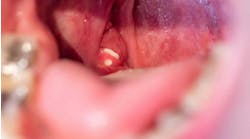BY Karen Davis, RDH, BSDH
"Drinking from a fire hose" is the most common description participants use to describe the two-day Bale Doneen Method preceptorship course. In May 2015, I participated in my first (but certainly not my last) preceptorship training along with other registered dental hygienists, dentists, cardiologists, internists, general practitioners, registered nurses, dieticians, and other health-care professionals.
Many in attendance were there for their second, third, or fourth training since the abundance of information presented is overwhelming, and life-altering.
If you don't know about the Bale Doneen Method: Paradigm Shift in CVD Prevention, but have a beating heart, or you treat patients with beating hearts, I hope you will dive in to your own investigation of this curriculum. Bradley Bale, MD, and Amy Doneen, DNP, ARNP, are co-founders of this curriculum.
Just read and digest their mission statement: "To make the Bale/Doneen method known and available worldwide, in order to prevent heart disease, strokes, and diabetes, thereby enhancing the quality of life for every man, woman, and child."
Seriously? Is that possible? Well, both of these health-care professionals are busy treating their own patients and teaching colleagues worldwide exactly how to accomplish that. Why the urgency? Well, according to 2013 data published by the American Heart Association, the average number of years of life lost because of heart attack is 16.6!1
As Amy Doneen says, "That's not OK!"
Similar to the way dental hygienists become "private detectives" of the oral cavity, the Bale Doneen method teaches health-care providers to uncover root causes that contribute to patients' arteries becoming inflamed, which lead to heart attacks and strokes. Their proven approach to preventing CVD revolves around altering root causes in a dynamic and proactive way. Traditionally, medicine has treated cardiovascular diseases and Type II diabetes after there is a diagnosis and known problems-by placing stents upon discovering blocked arteries, for example, performing bypass surgery to establish new pathways for blood flow, or prescribing medications to reduce blood sugar.
In contrast, the Bale Doneen method is uniquely positioned to eradicate heart attack, strokes, and diabetes with proper intervention and treatment.
How is this accomplished, and what is the role of the dental professional to ensure a patient's success? Maintaining arterial wellness as taught by Brad Bale and Amy Doneen encompasses understanding, and acting upon the the following nine components:
• Education
• Disease
• Fire
• Roots
• Optimal
• Genetics
• Individual management
• Risk factor response
• Assess disease annually
Sounds daunting, but Drs. Bale and Doneen unpack well-researched and persuasive evidence during the two-day curriculum to assist health-care professionals approach disease prevention differently.
Let me give you a few examples. X-rays of the carotid arteries are good at identifying hard-calcified deposits but will miss soft uncalcified plaques. In combination with chronic inflammation, soft, uncalicified plaques are more likely to rupture and contribute to coronary events. Use of ultrasound technology, with specific software to measure plaque burden inside the artery and labs tests to measure inflammatory markers are all part of the discovery process advocated in the Bale Doneen Method.
Additionally, data confirms that periodontal pathogens such as Fusobacterium nucleatum have the ability to increase permeability and weaken the protective endothelial lining of arteries around the heart,2 increasing the risk of heart attack and strokes as plaques break free. Identifying specific periodontal pathogens and eliminating active periodontal infection becomes a critical component of maintaining arterial wellness. The oral-systemic connection is what attracts a broad range of health care providers and dental professionals to Bale Doneen Preceptorship training.
Another example of how the Bale Doneen Method reduces risk of heart attack and stroke has to do with understanding the role of genetics and disease. It is estimated that approximately 40% of cardiovascular arterial disease is due to genetics. The 9p21 genotype has been referred to as the "heart attack gene" due to its prevalence independent of other known risk factors in patients suffering from heart attacks.3 The Bale Doneen Method includes analysis of specific genetic markers to personalize dietary recommendations, exercise regimens and medication choices.
So how common is it for patients to have elevated risks for cardiovascular disease and have absolutely no evidence or symptoms? Evidently, very! Imagine my surprise when results of my own carotid intima-media thickness (CIMT) test taken during the Bale Doneen training revealed that my "arterial age" is 11 years greater than my chronological age! Suddenly I realized that I am the exact type of patient the Bale Doneen Method applies to: elevated risk, asymptomatic, with evidence of disease.
The next step for me? Work closely with a Bale Doneen trained physician to proactively reduce my risks to prevent heart attack, stroke, and diabetes, and inform my patients about CVD prevention.
We don't have to settle for being a statistic of individuals whose first sign of CVD is a heart attack or stroke, and neither should our patients. RDH
References
1 Go AS, et al. Heart disease and stroke statistics - 2013 update: A report from the American Heart Association. Circulation 2013 127(1) e6-e245
2 Fardini Y, et al. Fusobacterium nucleatum adhesin FadA binds vascular endothelial cadherin and alters endothelial integrity. Mol Microbiol. 2011 Dec;82(6):1480-80
3 Ganesh SK, et.al. Genetics and Genomics for the prevention and treatment of cardiovascular disease: Update: A scientific statement from the AHA. Circulation 2013 Dec 24;128(25):2813-51
4 Doria A, et al. Interaction between poor glycemic control and 9p21 locus on risk of coronary artery disease in type 2 diabetes. JAMA 2008 Nov 26;300(20):2389-97
Karen Davis, RDH, BSDH, is the founder of Cutting Edge Concepts, an international continuing education company, and practices dental hygiene in Dallas, Texas. She is an independent consultant to the Philips Corp., Periosciences, and Hu-Friedy/EMS. She can be reached at [email protected].





